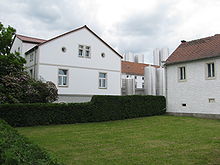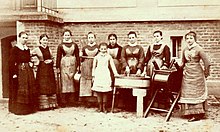Heinrichsthal (Radeberg)
|
Heinrichsthal
Large district town of Radeberg
Coordinates: 51 ° 7 ′ 37 ″ N , 13 ° 56 ′ 33 ″ E
|
|
|---|---|
| Height : | 260 m above sea level NN |
| Postal code : | 01454 |
| Area code : | 03528 |
The Heinrichsthal (also: Heinrichstal ) is a locality of the large district town Radeberg in the district of Bautzen , Saxony .
geography



The Heinrichsthal is located in the northeast of the Radeberg urban area in the Radeberg district . Neighboring locations or settlements are the Radeberger outskirts settlement Am Taubenberg in the east and the Friedrichstal in the west. Radeberg city center extends about two kilometers to the southwest. The Arnsdorf district of Wallroda is southeast of the Heinrichsthals , and to the northeast is the Wachau district of Leppersdorf .
The small village of Heinrichsthal itself essentially consists of the buildings of the Heinrichsthaler Milchwerke . You are on Großröhrsdorfer Straße, which leads from Radeberg to Großröhrsdorf . The RVD bus route 305 runs on it from Dresden to Bischofswerda . The buses stop directly at Heinrichsthal.
Agriculturally used areas surround the location, which also includes a park with old trees. A small stream valley runs in the north and south; in the south the Heinrichsthaler ponds were dammed for fish farming. One kilometer south of the Heinrichsthales the Große Röder flows in an east-west direction through the Hüttertal , two kilometers north of the village there is a forest area with the Landwehr .
history
Early history
The Heinrichsthal was already a Vorwerk in the 14th century , the so-called "Radeberger Schlossvorwerck". It belonged to Radeberg Castle, which Duke Moritz had converted into the Klippenstein official and hunting lodge from 1543 . In the loan book of Margrave Friedrich the Elder , four outworks are mentioned in the “ Districtus Radeberg” around 1350, and the existence of the castle outworks is documented in invoices for the Radeberg office as early as 1414. In 1558, Elector August von Sachsen (Father August) sold the Vorwerk including the courtyard corridors comprising 480 bushels (around 140 hectares ) of land to the city of Radeberg. The Vorwerk mainly served agricultural purposes. In 1697 the Radeberg tax collector Johann Christoph Klette was the owner of the Vorwerk, after him it was called "Kletten-Vorwerck" for a long time. JC Klette's descendants were the owners of the Vorwerk until Heinrich Traugott Klette's death in 1798. It was later named "Graues Vorwerck", probably because of the color of the facade at the time. In 1831 the city councilor JB Hache was Vorwerk owner. From 1836 it was again owned by the city for about 20 years. In 1865 Johann Gottlob Schütze was the owner, he arranged for a milk vault to be added to the former house. In 1868 the Radeberg master builder Wilhelm Reinhard Würdig became the new owner of the Vorwerk. He had the side building of the property enlarged and the farmhouse located directly on the street extended and raised considerably. On the left the restaurant with side rooms ("Wirtshaus zum Heinrichsthal") and on the right stables and coach houses. The owner's apartment and warehouse floors were set up on the new upper floor. The large central entrance portal led into the manor, which was closed to the north with a large barn. This was later converted into the main production building of the Heinrichsthal dairy. From 1872 onwards, he dignified the brick factory that was already on his Vorwerk property east of the estate when he bought it in 1868 by building an annular brick kiln, and in 1874 a second kiln was built. The clay pits were adjacent to the northeast. Worthy leased the brickworks to master bricklayer Bauer.
Era of Zeis
Around 1877 Würdig sold the entire Vorwerk Heinrichsthal including all parcels (at that time about 57 hectares), brickworks and buildings to Hermann Alexander Zeis, the husband of Agathe Zeis . These founded here in 1880 a teaching dairy farm and taught daughters of farmers in dairying. In 1884 it was granted a patent for the production of French-style soft cheese , which made Heinrichsthal the first production site for Camembert and, a little later, Brie and Neufchâtel in the German Empire . From 1878, the new owner Zeis had a new residential building (manor house) built and the stable building east of the manor entrance to be expanded into a much larger cattle stable. The apprenticeship dairy founded by Agathe Zeis in Heinrichsthal in 1880 was relocated in 1882 to a new building between the manor house and the barn, which became a production building for the new cheeses from 1883. In order to be able to meet the increased demand, the Zeis couple set up a dairy in Löbau in 1884 (especially for the production of Neufchâtel) and in Bautzen in 1886, and in 1886 they set up a dairy in the dairy in Lauterbach in Hesse .
Because of the high demand for building materials, Zeis had a third ring kiln built in his brick factory in 1882. In 1887 he built a considerably larger stable and barn building in place of the old barn. Also in 1887, due to the current economic success of the dairy, Zeis had the large stable and barn building at the rear, parallel to the street, converted and expanded into a modern production building for cheese production. All of these construction measures were in the hands of the Radeberg master builder Robert Schmutzler.
These investments required high financing costs and the taking on of liabilities . In contradiction to the sporadic economic success of the dairy, however, was the generally not proportionally increasing sales and consumption of dairy products. The resulting oversupply led to a general drop in prices and also to existential financial difficulties in Heinrichsthal. As a result, the Royal District Court of Radeberg filed for bankruptcy over the Zeis couple's assets in December 1887 and set the foreclosure auction of the property in the Heinrichsthal suburb with an estimated value of 157,000 marks for May 31, 1888, the sole owner of which was Hermann Alexander Zeis. The Felix Tower , which has belonged to Vorwerk Heinrichsthal since 1876 but is located in Wallrodaer district , was also part of the bankruptcy estate . The Lehrmeierei Heinrichsthal was deleted from the commercial register. The Löbau dairy had to be sold and the lease agreement with Bautzen dissolved.
1888–1945 era
The Radeberg master builders Robert Schmutzler and Friedrich Wilhelm Richter bought the land built with the dairy and brickworks, including the adjacent green and arable land, before the foreclosure auction scheduled for May 31, 1888, and thus became joint owners of the Heinrichstal suburb. Construction of an ice house for the dairy and a brick drying plant began in 1888. Schmutzler and Richter leased the Heinrichsthal brickworks to C. Schellmann, who operated under the name of “Dampfziegelwerke Radeberg Carl Schellmann & Co.” as the lessee.
In 1889 the construction of an in-house kindergarten was approved. In 1890, Schmutzler and Richter built a summer pavilion with a guest garden on the opposite side of the street belonging to the "inn". As part of the expansion of the previous communication route between Radeberg and Großröhrsdorf to a 2-lane country road in the years 1888 to 1890, on the advice of Schmutzler and Richter, the Heinrichsthales was upgraded as the eastern “gateway to the city”. Both of them made it possible to create a lime tree avenue by providing their property shares free of charge and bearing the costs for trees and planting. In 1891 they both built a new, slightly set back stall for 48 cattle parallel to the street. In 1892 the inn was expanded into a "restoration building".
Around 1897 Heinrich Prinz and Albert Linke (former authorized signatory of the dairy) are named as tenants of the dairy. In 1905 Albert Linke is the sole owner of the Vorwerk. From 1906 the dairy operated as "Meierei Heinrichsthal Albert Linke. Royal Saxon and Grand Ducal Hessian Court Supplier ”. The latter title is based on the establishment of the cheese dairy in Lauterbach (Hesse) in 1886. The brickworks operated from 1897 as "Radeberger Dampfziegel GmbH" and from 1909 under its owner Linke as "Ziegelei Heinrichsthal", until in 1918 brick production was stopped.
In 1927 Linke allowed the tenant of the inn to set up a small bore shooting range on the site of the disused brickworks. In 1933, Linke had all of the brickworks structures, including chimneys and shooting range, torn down.
After 1945
After the end of the Second World War , the Heinrichsthal came under Soviet command. In 1947 the VdgB dairy cooperative Radeberg was founded, from which the VEB Milchkombinat Radeberg with its external plants Lehndorf , Leutwitz and Burkau emerged. After the fall of the Wall in 1991, Gebr. März AG from Rosenheim took over Heinrichsthal and converted it to Heinrichsthaler Milchwerke GmbH in 1992. In 1994 the Radeberger dairy cooperative bought back its shares and is still the sole shareholder of Heinrichsthaler Milchwerke GmbH.
The Vorwerk Heinrichsthal transformed into a large dairy within a few years. A large part of the estate was built over as a result. To this day, however, some buildings from the 19th century have been preserved, including the administrative headquarters (former manor house), the fabric of the production building erected in 1887 and the building block on the street front, the former economic building with the former "Wirtshaus zum Heinrichsthal" . The large guest garden to the west is now a park-like tree population. Around 1970 and after 2000, major renovations and new buildings took place on the site. In 1992, another larger company, Radeberger Fleisch- und Wurstwaren Korch GmbH, settled in the immediate vicinity, roughly on the site of the former brickworks.
literature
- Dresdner Heide, Pillnitz, Radeberger Land (= values of our homeland . Volume 27). 1st edition. Akademie Verlag, Berlin 1976.
- Prof. Dr. Peter Schmutzler: The historical buildings and structures of the former Heinrichsthal plant . In: Radeberger Blätter zur Stadtgeschichte. Volume 14, 2016. Ed .: Large district town of Radeberg in cooperation with the AG Stadtgeschichte.
- Wilfried Lumpe: Our brickworks - out and forgotten . In: Radeberger Blätter zur Stadtgeschichte. Volume 9, 2011. Ed .: Large district town of Radeberg in cooperation with the AG Stadtgeschichte.
Individual evidence
- ↑ Chronicle of Klippenstein Castle
- ↑ Scheffel (saat), old Saxon area measure ( memento of the original from March 4, 2016 in the Internet Archive ) Info: The archive link was inserted automatically and has not yet been checked. Please check the original and archive link according to the instructions and then remove this notice.
- ↑ a b c d e f Prof. Dr. Peter Schmutzler: The historical buildings and structures of the former Heinrichsthal plant . In: Radeberger Blätter zur Stadtgeschichte. Volume 14, 2016. Ed .: Large district town of Radeberg in cooperation with the AG Stadtgeschichte.
- ↑ Radeberger Chronik 1550-1839 . Handwritten manuscript. Archive no. 00003476. Museum Schloss Klippenstein Radeberg
- ↑ a b c Wilfried Lumpe: Our brickworks - out and forgotten . In: Radeberger Blätter zur Stadtgeschichte. Volume 9, 2011. Ed .: Large district town of Radeberg in cooperation with the AG Stadtgeschichte.
- ^ Heinrichsthaler Camembert on Landwirtschaft.sachsen.de ( Memento from August 3, 2014 in the Internet Archive )
- ↑ Manfred Schollmeyer : Secrets about the mother of the German Camembert . In: Sächsische Zeitung from January 6th / 7th 2018
- ↑ Saxony's castles, Vorwerk: Heinrichsthal Radeberg
- ↑ WHO to WEM company database



